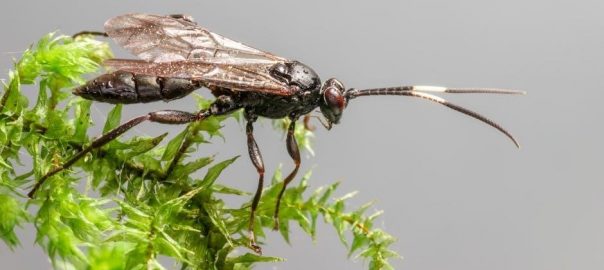Identifying insect eggs is crucial for understanding their life cycles and ecological roles, offering insights into species diversity, behavior, and habitat preferences through their unique characteristics.
1.1 Importance of Identifying Insect Eggs
Identifying insect eggs is essential for understanding their ecological roles, life cycles, and potential impacts. It helps determine whether eggs are harmful, beneficial, or neutral, guiding pest management strategies. Early detection prevents infestations, protecting crops and homes. Additionally, identifying eggs supports conservation efforts by distinguishing pollinators or predators. This knowledge aids in targeted interventions, ensuring balanced ecosystems. Using field guides and digital tools enhances accuracy, making insect egg identification a vital skill for gardeners, farmers, and environmentalists alike.
1.2 Overview of Insect Egg Characteristics
Insect eggs exhibit diverse traits, varying in size, shape, color, and texture. Sizes range from microscopic specks to visible pellets, with colors spanning white, cream, brown, or metallic hues; Shapes are typically oval, spherical, or elongated, while textures may be smooth, ridged, or patterned. These characteristics, combined with habitat clues, aid in identification. Understanding these traits helps distinguish species, providing insights into their ecological roles and life cycles. Accurate observation of these features is key to successful identification.
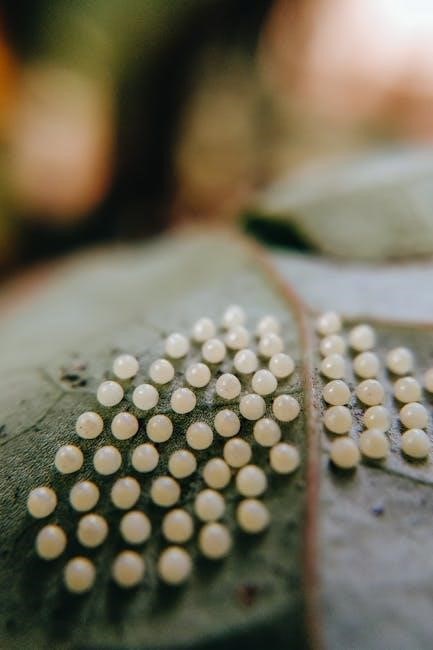
Common Characteristics of Insect Eggs
Insect eggs vary widely in size, shape, color, and texture, offering key traits for identification. These characteristics help distinguish species and provide insights into their biology and habitats.
2.1 Size and Shape of Insect Eggs
Insect eggs exhibit a wide range of sizes and shapes, from the tiny, elongated eggs of mosquitoes to the larger, rounded eggs of beetles. The size can vary from less than a millimeter, as seen in mosquito eggs, to several millimeters for larger insects. Shapes are equally diverse, with some eggs being spherical, oval, or even cylindrical, reflecting adaptations to their specific environments and the needs of the developing larvae. These physical traits are vital for identification.
2.2 Color Variations in Insect Eggs
Insect eggs display a wide array of colors, from white and cream to brown, green, and even metallic hues. These variations help with camouflage or signaling. For instance, bed bug and flea eggs are often pale, while others may have darker tones for protection. Color can also indicate species and stages of development, making it a valuable trait for identification and understanding ecological adaptations. This diversity in coloration enhances survival and evolutionary success in various environments.
2.3 Texture and Surface Features
The surface texture of insect eggs varies significantly, aiding in identification. Some eggs are smooth, while others may be ridged, pitted, or adorned with intricate patterns. Lacewing eggs, for example, are attached by fine filaments, whereas stink bug eggs often have a textured, almost bumpy surface. These features not only provide protection but also help in adhering to surfaces. Observing these details can be crucial for distinguishing between species and understanding their adaptive strategies in different environments. Texture adds another layer of complexity to identification, enhancing accuracy when combined with other characteristics.
Identifying Insect Eggs by Location
Insect eggs are found in diverse locations, from leaves and stems to soil, water, and even homes. Their placement often reflects species-specific adaptations, aiding identification.
3.1 Eggs on Leaves and Stems
Insect eggs on leaves and stems are often laid in strategic locations to ensure survival. Lacewing eggs are attached by fine filaments, while whiteflies lay theirs on leaf undersides. Aphids and caterpillars like Helicoverpa often deposit eggs near plant veins for protection. Eggs on stems may be hidden in bark crevices or under plant debris. Their textures vary from smooth to ridged, and colors range from pale to dark, aiding camouflage. Identifying these eggs requires observing their placement and plant-specific associations.
3.2 Eggs in Soil or Ground
Insect eggs in soil or ground are often laid by species like grasshoppers and ground beetles. Grasshopper eggs are typically arranged in pods or capsules, while others may be scattered. These eggs are usually cream or white, with textures ranging from smooth to ridged. They are often protected by soil cover or plant debris, making them less visible. Identifying these eggs requires careful observation of their placement, color, and structural patterns, as their habitat plays a key role in their survival and detection.
3.3 Eggs in Water or Near Water Sources
Insect eggs found in water or near water sources, such as mosquito eggs, are often laid on the surface or submerged. These eggs are typically small, ranging from specks to pellets, and may appear in clusters or rafts. Dragonfly and water strider eggs are often deposited near water edges. Their colors vary from white to dark, blending with aquatic environments. Identifying these eggs requires observing their placement, shape, and texture, as they are adapted to survive in or near water, ensuring their survival in aquatic ecosystems.
3.4 Eggs Found in Homes or Buildings
Insect eggs in homes or buildings are often laid in hidden areas like cracks, carpets, or furniture. Bed bug eggs are small, white, and typically found in bedding or mattresses, while flea eggs may appear in pet areas. Carpet beetle eggs are usually pale and oval-shaped. Identifying these eggs is crucial for determining potential pests and taking preventive measures. Early detection helps in controlling infestations, ensuring a safer and healthier indoor environment by addressing issues before they escalate into larger problems.
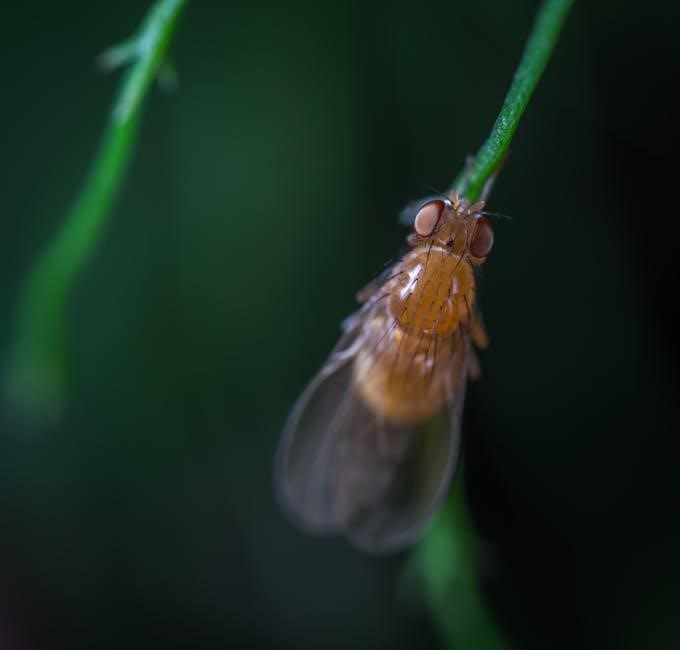
Common Types of Insect Eggs
Insect eggs vary widely in appearance, with species-specific characteristics like shape, color, and texture. Common types include butterfly, moth, beetle, wasp, bee, and fly eggs, each with unique features that aid in identification and understanding their ecological roles as pests or beneficial insects.
4.1 Butterfly and Moth Eggs
Butterfly and moth eggs are typically small, ranging in size from 0.1 to 2 millimeters, and are often spherical or oval in shape. They are usually laid on the leaves of host plants, with colors varying from white to yellow or green, sometimes featuring intricate patterns. Some species, like monarch butterflies, have eggs with distinct ridges, while others, such as lacewings, attach their eggs to leaves with fine filaments for protection.
4.2 Beetle Eggs
Beetle eggs are usually white or light-colored, ranging in shape from oval to cylindrical. They are often laid in protected locations such as soil, plant tissues, or under tree bark. Some species, like the lady beetles, lay eggs in clusters, while others, such as weevils, deposit eggs singly in specific habitats. The size varies from 0.5 to 2 millimeters, and the surface texture can be smooth or slightly ridged, depending on the beetle species.
4.3 Wasp and Bee Eggs
Wasp and bee eggs are typically white, ranging in size from 0.5 to 1.5 millimeters. They are usually oval or elongated in shape. Wasps often lay eggs in protected locations like nests or plant tissues, while bees deposit eggs in cells within their hives or underground nests. Some wasp eggs may have a filament-like structure at one end, while bee eggs are often smooth and elongated, making them distinguishable based on their habitat and surrounding structures.
4.4 Fly Eggs
Fly eggs are small, typically white or pale yellow, and often laid in clusters. Mosquito eggs are about 1mm long, while house fly eggs are slightly larger. They are usually ovular or elliptical in shape. Flies prefer moist environments for laying eggs, such as near water sources or decaying matter. The eggs hatch quickly, often within 24 hours, making them a common sight in humid areas. Their size and location are key identifiers for species-specific traits and ecological roles.
Distinguishing Harmful vs. Beneficial Eggs
Identifying harmful or beneficial eggs helps determine their impact on ecosystems or crops. Harmful eggs, like pests, may damage plants, while beneficial eggs, such as lacewings, aid biological control.
5.1 Harmful Insect Eggs (e.g., Pests)
Harmful insect eggs, such as those of mosquitoes and certain beetles, can indicate potential pest infestations. Mosquito eggs are often laid in water, while wasp eggs may be found in nests. Aphid eggs are small and typically found on plants, causing damage. Beetle eggs can be oval or round, leading to crop destruction. Identifying these eggs early helps prevent infestations and protects agricultural or household environments from potential threats.
5.2 Beneficial Insect Eggs (e.g., Pollinators)
Beneficial insect eggs, such as those from bees and ladybugs, are vital for pollination and pest control. Bee eggs are often white and found in hives, while ladybug eggs are typically yellow and laid near aphid colonies. These eggs contribute to ecosystem balance and agricultural health by supporting biodiversity and maintaining ecological harmony, making their identification essential for conservation and environmental sustainability efforts.
Tools and Resources for Identification
Field guides, online databases, and microscopes are essential tools for identifying insect eggs, offering detailed descriptions, high-quality images, and precise examinations to aid in accurate species determination.
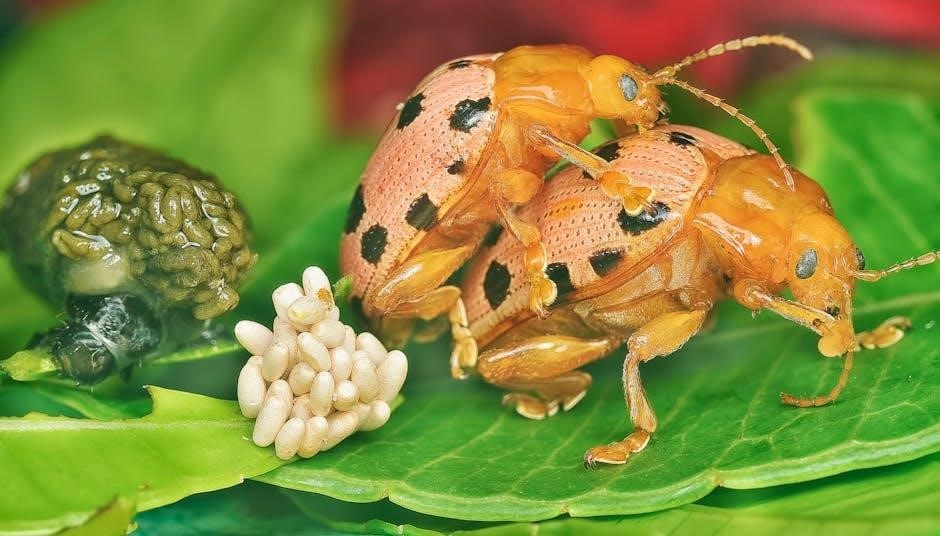
6.1 Field Guides and Reference Books
Field guides and reference books are indispensable for insect egg identification, offering detailed descriptions, high-quality images, and species-specific information. These resources often include life cycle stages, habitat preferences, and diagnostic features, aiding in accurate identification. They are particularly useful for gardeners, researchers, and pest management professionals. Portable and comprehensive, field guides provide quick access to essential information, while reference books offer in-depth insights for advanced study. Together, they form the foundation for successful insect egg identification.
6.2 Online Databases and Apps
Online databases and apps provide accessible tools for insect egg identification, offering searchable databases, image libraries, and species databases. Apps like iNaturalist enable users to upload photos for community-driven identification. Digital platforms often include filters for size, color, and habitat, aiding quick identification. Some databases incorporate AI for advanced matching, making them invaluable for researchers and enthusiasts alike. These resources complement traditional guides, offering updated and interactive identification support for insect eggs.
6.3 Microscopic Examination
Microscopic examination is a crucial tool in insect egg identification, revealing intricate details like surface textures and structural features. High-resolution microscopy can capture fine patterns, such as ridges or pits, which are often unique to species. This method is particularly useful for distinguishing between eggs of similar appearance. By analyzing these microscopic characteristics, experts can accurately classify eggs, even when other identification methods fall short. Microscopy enhances precision, making it indispensable in scientific and forensic entomology.
Step-by-Step Identification Guide
A systematic approach to identifying insect eggs involves observing size, shape, color, and texture, followed by habitat analysis to narrow down species accurately and efficiently.
7.1 Observing Egg Size and Shape
Examining the size and shape of insect eggs is crucial for identification. Eggs vary in length from less than a millimeter to several millimeters. Shapes range from spherical to oval or elongated. For instance, mosquito eggs are tiny and boat-shaped, while wasp eggs are slightly larger and cylindrical. Accurately measuring and noting these physical attributes helps narrow down potential species, as specific shapes often correlate with particular insect families or genera. This step is foundational for further analysis. Additionally, some eggs may be laid in clusters or protected by coverings, which can provide further clues. Observing these details requires magnification and careful documentation to ensure accuracy. By systematically recording size and shape, one can effectively categorize eggs and proceed with more detailed identification processes. This methodical approach ensures that no critical characteristics are overlooked, enhancing the reliability of subsequent steps in the identification process.
7.2 Noting Color and Texture
Color and texture are vital for identifying insect eggs. Eggs can be white, yellow, green, brown, or even metallic. Some, like aphid eggs, are waxy and white, while others, such as stick insect eggs, have textured surfaces. Observing these traits helps distinguish species, as patterns and colors often indicate specific habitats or developmental stages. Documenting these details enhances identification accuracy, as subtle variations can signify different species. This step is essential for narrowing down possibilities and ensuring precise classification.
7.3 Considering the Habitat
The habitat where insect eggs are found provides crucial clues for identification. For example, eggs laid on leaves often belong to butterflies or beetles, while those in soil may be from grasshoppers or crickets. Aquatic insects like mosquitoes lay eggs near water, and some species attach their eggs to plants using silk threads. Understanding the environment helps narrow down possible species, as certain insects prefer specific substrates or locations for egg-laying, which can also indicate their ecological role or potential impact. This step is essential for accurate identification and management strategies.
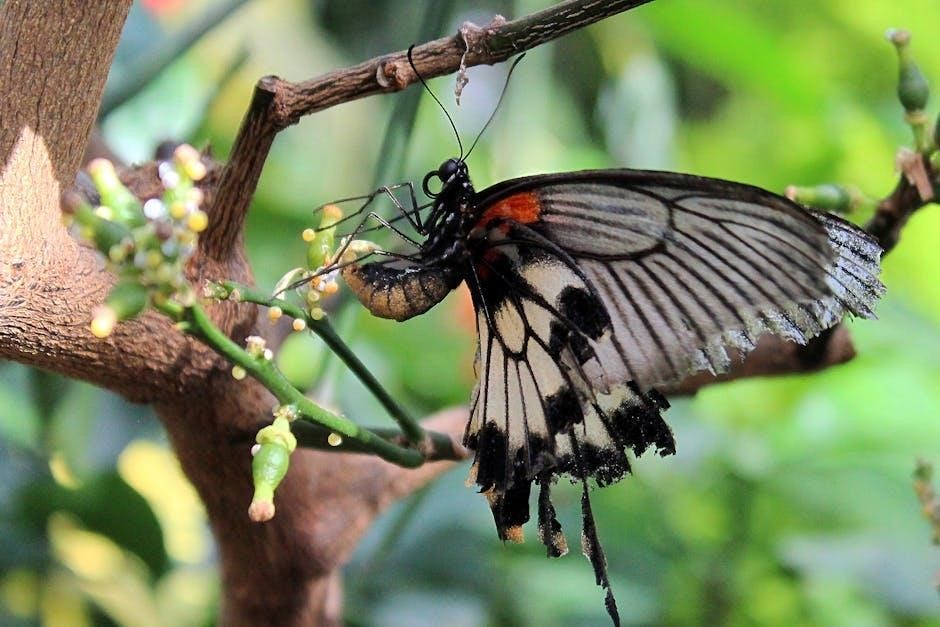
Role of Images in Identification
High-quality images are essential for accurate insect egg identification, allowing detailed comparison with reference materials and aiding in distinguishing subtle characteristics that may otherwise go unnoticed.
8.1 High-Quality Photos for Accurate ID
High-quality photos are indispensable for accurate insect egg identification, capturing essential details like color, shape, and texture. Clear, well-lit images, often taken with macro photography, reveal intricate features that distinguish species. These visuals, found in field guides or online databases, enable precise comparisons, helping to avoid misidentification. Utilizing such images alongside expert resources ensures a more reliable and efficient identification process, making them a cornerstone of modern entomological studies and pest management strategies.
8.2 Comparing with Reference Images
Comparing unknown insect eggs with reference images is a cornerstone of accurate identification. Utilize online databases, field guides, or specialized apps to find matching visuals. Pay attention to color, shape, and texture, as these features often distinguish species. High-quality reference images highlight key characteristics, such as the presence of filaments or surface patterns, aiding in precise matches. Regular updates in these resources ensure the inclusion of newly discovered species or variations, enhancing reliability for enthusiasts and professionals alike.
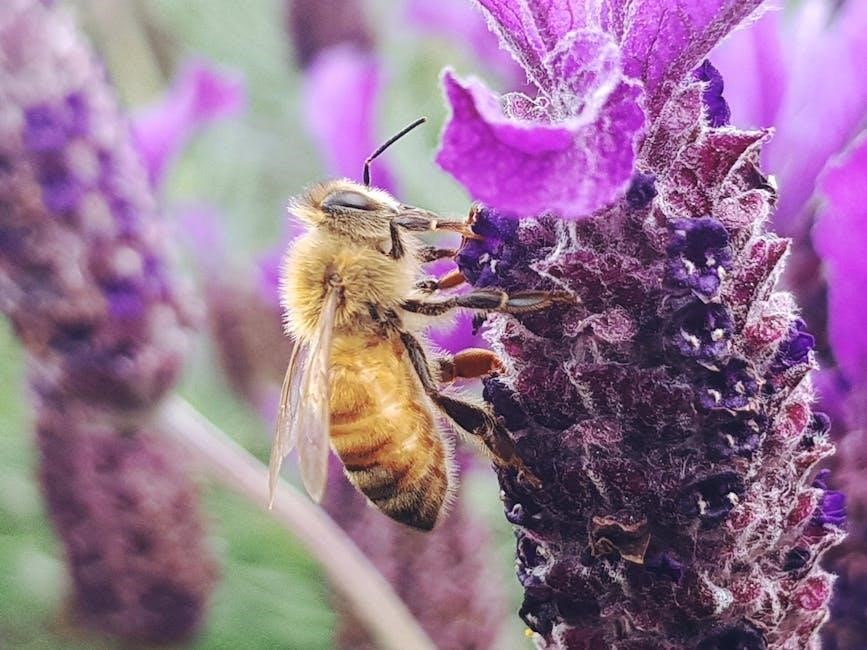
Preventing and Controlling Insect Eggs
Preventing insect eggs from hatching or spreading is key to managing pests. Use organic methods like neem oil or insecticidal soap, and chemical treatments as needed. Regular monitoring ensures early detection, allowing timely intervention to prevent infestations and protect plants or spaces from potential damage caused by harmful insects.
9.1 Organic and Chemical Methods
Organic methods include using neem oil, insecticidal soap, and diatomaceous earth to deter or kill insect eggs. Chemical treatments, like pyrethrins or permethrin, are effective for severe infestations. Always apply these methods judiciously, following label instructions to minimize environmental impact. Combining both approaches can provide balanced pest management, ensuring ecosystem health while addressing specific pest challenges effectively.
9.2 Monitoring and Early Detection
Regular inspections of plants, soil, and surfaces are vital for early detection of insect eggs. Use magnifying tools to spot eggs in hidden areas like leaf undersides or soil cracks. Identify eggs by their size, color, and texture, noting their arrangement or clustering patterns. Early detection allows timely intervention, preventing infestations from escalating. Monitoring habitats like gardens or indoor spaces helps track pest activity and ensures proactive management of potential threats, safeguarding ecosystems and property effectively.
Identifying insect eggs is crucial for recognizing harmful and beneficial species, aiding in effective pest management and ecological balance using tools like field guides and online databases.
10.1 Summary of Key Points
Insect egg identification is vital for understanding species behavior and ecological impact. Eggs vary in size, shape, and color, with specific locations indicating habitat preferences. Recognizing these characteristics helps distinguish between harmful pests and beneficial insects, aiding in effective pest management and conservation strategies;
10.2 Final Tips for Successful Identification
Observe egg size, shape, and color carefully, noting texture and surface features. Consult field guides or online databases for comparisons. Use microscopy for detailed examination; Practice regularly to improve skills, and stay updated with new resources and research for accurate identification of insect eggs in various environments and contexts.

Additional Resources
Explore recommended websites and suggested reading materials for deeper insights into insect egg identification, enhancing your knowledge with diverse resources and expert recommendations.
11.1 Recommended Websites
Several websites offer valuable resources for insect egg identification. BugGuide.net provides detailed images and species information. iNaturalist.org allows users to upload photos for expert identification. Additionally, royalty-free stock images from sites like iStock and Shutterstock can aid in visual recognition. The University of California’s IPM website features photographs of common insect eggs, while entomology forums often share insights and identification tips. These platforms collectively enhance your ability to accurately identify insect eggs.
11.2 Suggested Reading Materials
For comprehensive learning, consider field guides like “Insect Eggs and Immatures” by Peter C. Barnard and Roy H. Thomas. “The Life of Insects” by Patrick Roques offers insights into insect development. Additionally, “A Field Guide to the Birds and Insects of North America” by Roger J. Lederer provides vivid descriptions. These books, along with online resources, offer detailed information on insect egg characteristics, aiding enthusiasts and professionals in accurate identification and understanding of various species.
Insect Egg Identification Key
A systematic guide to recognizing insect eggs, this key helps users identify species by observing size, shape, color, and texture, enabling accurate classification and study.
12.1 Creating a Personal Identification Guide
Developing a personal insect egg identification guide involves compiling detailed notes, high-quality images, and sketches. Start by documenting size, shape, color, and texture of eggs encountered. Include their habitat and host plants or surfaces where found. Organize entries alphabetically by species or categorically by habitat type. Regularly update the guide with new discoveries and cross-reference with field guides or online databases for accuracy. This tool becomes invaluable for personal study and quick identification in the field.
